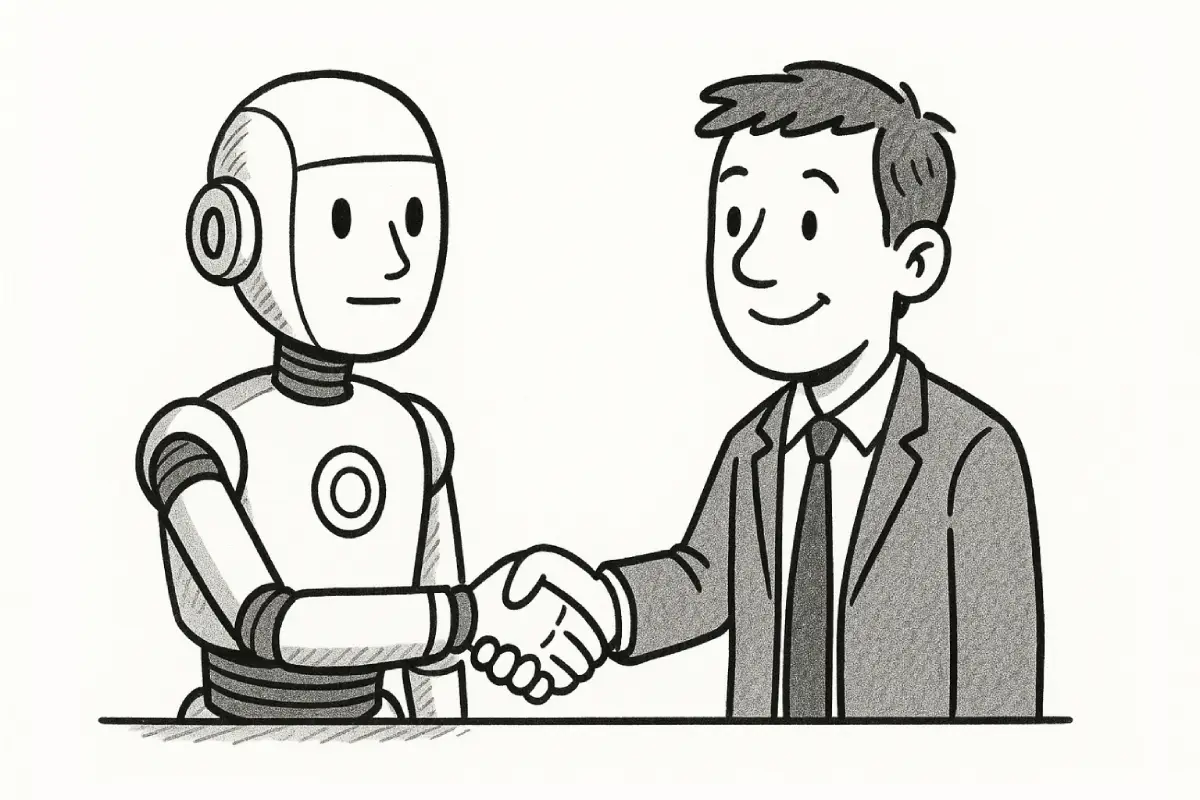You’re sitting in your spare bedroom, wearing a nice shirt and pajama pants—the official uniform of the remote-work era. You’re staring into the unblinking, soulless eye of your webcam. And you’re trying to smile.
It’s not a real smile. It’s a strained, slightly pained grimace that you hope registers as “pleasantly enthusiastic.” You’re talking to a box. An empty interface. But you know you’re being watched. Not by a person, not yet. You’re being watched by an algorithm. A piece of software is analyzing your word choices, the pitch of your voice, the way your eyes dart around when you’re thinking. It’s judging you.
Welcome to the AI interview. It’s no longer the stuff of sci-fi B-movies. It’s here. And it’s just as weird and unnerving as it sounds.
Companies will tell you it’s about “removing bias” and “increasing efficiency.” A noble-sounding load of corporate hogwash. What it’s really about is saving them time by using a bot to sift through the first round of candidates. Your first hurdle in landing a dream job isn’t a human being you can charm or connect with. It’s a digital bouncer with a very specific, very literal checklist.
It feels dystopian because it kind of is. But here’s the good news: the bot is stupid.
I don’t mean that in a metaphorical sense. I mean it’s literally just a complex pattern-matching machine. It’s not thinking. It’s not feeling. It’s not “getting” your nuanced, witty anecdote about that time you saved a project with your quick thinking. It’s just scanning for data points. Keywords. Facial tics. Vocal tones. And it’s comparing all that data against a pre-loaded profile of what a “good” candidate looks and sounds like.
So, your job isn’t to impress the bot. Your job is to beat the bot. You just need to learn the rules of its very dumb game.
Rule #1: The Job Description Is Your Cheat Sheet
This is the most important thing to understand. The AI has been fed the job description. It has been programmed to look for the words and phrases in that document. Your goal is to become a human parrot.
Seriously. Print out the job description. Get a highlighter. Mark up every key skill, every buzzword, every bit of corporate jargon they use.
“Seeking a dynamic team player with a proven track record in cross-functional collaboration and stakeholder management.”
Your mission, should you choose to accept it, is to sprinkle those exact phrases into your answers. Not awkwardly, not like you’re a malfunctioning cyborg, but naturally. Weave them in.
The Bot-Baiting Answer: When it asks, “Tell me about a time you worked on a team,” you don’t just tell a story. You frame it with their language.
“Absolutely. In my last role, a key project required significant cross-functional collaboration. I took the lead on stakeholder management, ensuring that the engineering, marketing, and sales teams were all aligned. It was a fantastic example of being a dynamic team player, and we ultimately delivered the project 15% ahead of schedule.”
Did you just use a nauseating amount of corporate-speak? Yes. Does the bot love it? You bet your data points it does. You’re literally checking its boxes in real-time. It’s not about being authentic at this stage. It’s about getting past the gatekeeper.
Rule #2: You’re an Actor, Not an Applicant
The AI isn’t just listening. It’s watching. Companies use platforms like HireVue that analyze tens of thousands of data points related to your “digital body language.” This includes:
- Your Tone of Voice: Are you speaking in a dreary monotone? The bot will flag that as “low engagement.” You need to modulate your voice. Sound interested, even if you’re talking to a Dell logo. Tell your stories with a little bit of vocal energy.
- Your Eye Contact: Don’t look at your own face on the screen. Don’t look at your notes off to the side. Look directly into the little green light of the webcam. To the bot, that’s eye contact. It’s weird, it’s unnatural, but it’s the rule. Pro tip: tape a little smiley face sticker right next to your webcam. It gives you a friendly spot to focus on.
- Your Facial Expressions: Yes, it’s watching your face. Are you smiling? Are you nodding? Do you look like you’re having a good time talking to an inanimate object? You should. Practice in the mirror. Find your “I’m actively listening and engaged” face. It feels ridiculous, but this is the game now.
You are putting on a performance. The role you’re playing is “The Ideal Candidate.” And that character is positive, engaged, and speaks directly into the camera.
Rule #3: Use the System’s Flaws to Your Advantage
The bot is a machine. And machines can be gamed. The fact that you’re at home, in your own space, gives you a home-field advantage.
The Open-Book Test: The bot can’t see what’s taped to the bezel of your monitor. You can have notes. You can have bullet points. You can have the entire job description stuck right there in your line of sight. Don’t read from a script—the bot will likely detect the rhythmic cadence and lack of spontaneity. But you can absolutely have key phrases, numbers, and reminders in front of you. It’s an open-book test. Use it.
Structure is Your Friend: Bots love structure. Humans love meandering stories; bots love data presented in a predictable format. This is the time to lean hard on the classic STAR method:
- Situation: Briefly set the scene.
- Task: What was your specific goal?
- Action: What did you do? Use those power verbs and keywords.
- Result: What was the outcome? Quantify it with numbers.
Answering in this format is like handing the AI a perfectly formatted report. It can easily parse the information, identify the keywords in the “Action” phase, and log the metrics from the “Result” phase. It’s clean. It’s efficient. It’s exactly what the machine is designed to reward.
You’re Not a Data Point
Does all of this sound a little soul-crushing? Yeah, it is. It’s another layer of absurdity in the already absurd theater of job hunting.
But don’t let it get you down. Remember the goal: get to a human.
This AI interview isn’t the final decision. It’s a filter. A crude, imperfect, easily-fooled filter. Your only job is to be the kind of data the filter is programmed to let through. You do that by feeding it the right words, putting on a bit of a show, and using the format to your advantage.
Once you’re past the bot, you can let your real personality shine. You can connect with a real person. You can ask nuanced questions and have a genuine conversation.
But first, you have to beat the bouncer. So take a deep breath, look that little green light dead in the eye, and give the machine exactly what it wants to hear.
You might also like: What Happens If Your Employer Misclassifies You as a Contractor?











